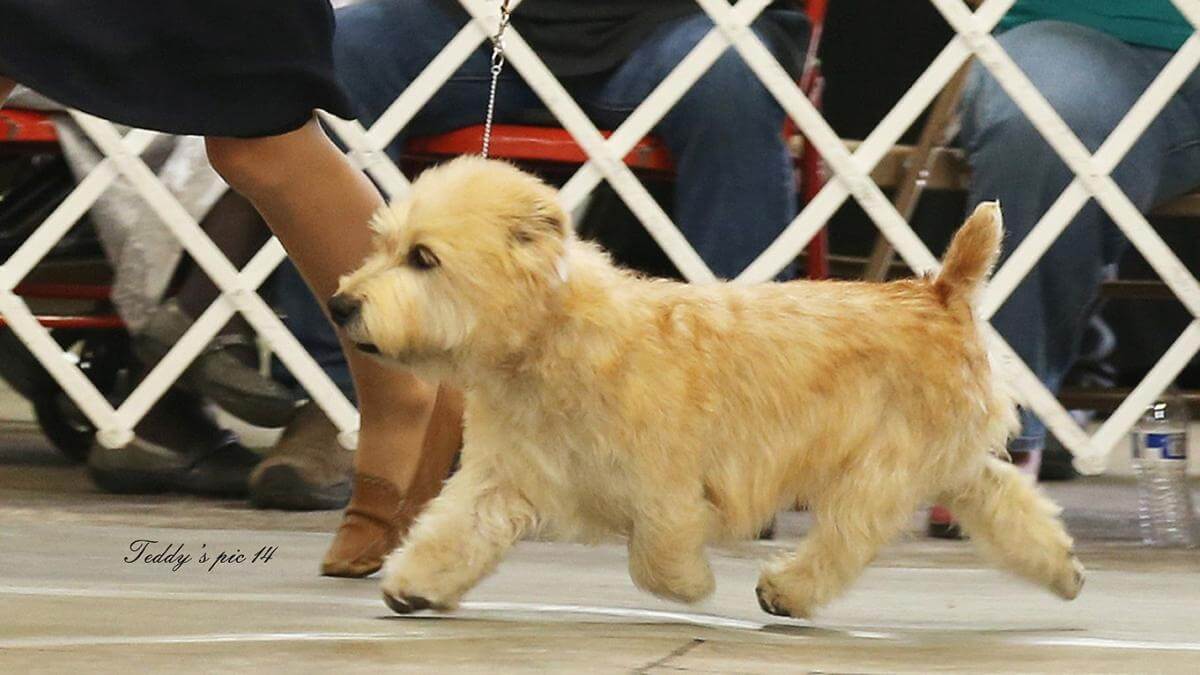


Home » Judging the Glen of Imaal Terrier

This article was originally published in Showsight Magazine, December 2010 issue.
First impressions are extremely important when judging the Glen of Imaal Terrier. The Glen should appear powerful and somewhat primitive in appearance. The breed’s ‘antique’ features and substance are critical to establishing type and understanding the breed.
The antique features – those hallmark traits once common to many early terrier types – include a head that seems almost too large for its sturdy body, a matched pair of rose or half-prick ears, slightly bowed front legs with a similarly slight turnout at the pasterns, and a longer-than-tall body profile with a slight rise to the rear. Two numbers resonate throughout the Standard: three and five. We are given to calling them the ‘magic numbers’ for the breed. The muzzle:skull ratio and height:length ratios are 3:5, and the approximate weight is 35 pounds. Glens should have a strong head with a round, medium-sized dark eye. Light eyes are objectionable. The skull should appear almost square when viewed from above and there should be a pronounced stop. The foreface should have good fill under the eye and taper slightly towards the muzzle with a black nose.
The teeth are big with full dentition and a preferred scissors bite. Level bites are acceptable. The ratio of muzzle to skull is 3:5. Ears are small for the head and are rose or half-pricked. Full drop or full prick ears are to be faulted. Also incorrect is a ‘mismatched pair’, that is, one rose and one drop ear or one half-prick and one drop ear. The topline is of particular importance and distinct to the breed’s history. It is straight (not level) with a strongly muscled loin and a slight rise to the highly set half-docked tail or natural tail. That’s a slight rise. Dogs with an extreme rise in the topline are often straight in the stifle or excessively bowed in the front legs. Regardless of length, the tail should be carried in the 12 to two o’clock position. There should not be a drop-off at the croup. The rising topline served a function in working Glens. It gave the dog leverage for pulling large vermin from dens and for walking the wheel or treadmill that drove a turnspit or churn. The ratio of height (withers to ground) to the length of body (point of chest to point of hip) is 3:5. The maximum height is 14” and the minimum is 121⁄2”. Though this is a range of only 11⁄2” in height, given that the breed is 40% longer than tall, this can mean there is upwards of 21⁄2” difference in length.
Add to that the third dimension of substance and you have a substantial range between the smallest and largest Glens. There is no preference for size and overall balance must always take precedence over any particular number. Glens should have well laid back shoulders leading to strong, short, bowed front legs. The forearm curves around the rib cage and the elbows are tight. The feet turn out slightly from the pasterns only. Correct Glens have enough forechest and keel to prevent fiddle-fronts. The hindquarters of a Glen are impressive. They are well-boned and muscled, have a well-defined second thigh, and good bend of stifle. They should never be soft or flabby since they are the driving forces of the dog. The Glen is the only one of the four terrier breeds of Ireland that is not defined by color. They come in an array of colors that fall within the Wheaten, Blue or Brindle ranges. There is no preference for color or depth of color. Regardless of color, the coat is harsh – not wire – with a soft undercoat.
It is kept at a medium length of approximately 11⁄2” over the body and longer on the head and furnishings. The hair of the furnishings is generally softer than the shorter body hair. It is also commonly a bit lighter in shade. The Glen should give the appearance of a rough and ready working terrier. He should never be overtrimmed. The coat is hand-stripped and NEVER scissored. It may be neatened by hand, but should never be sculpted. You may be surprised at how freely a Glen can move. They can cover ground well with good reach and drive. They are clean coming and going without paddling of forefeet and carry their tail gaily. Move them on a loose lead and allow room between dogs. We do not encourage sparring. Glens are generally gentle and docile, but can be exceptionally game when called upon. Their short, stocky bodies can be difficult to control if they are focused on a challenge. Aggression in the ring should never be tolerated. Any departure from the standard is considered a fault and the seriousness of the fault is in proportion to the degree of departure.